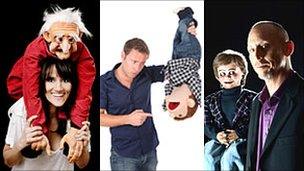Is ventriloquism making a comeback?
- Published
Sometime in the 1980s ventriloquism seemed to slip off our TV screens.
Keith Harris and Orville and Ray Allan with Lord Charles had been TV favourites but they disappeared from view as it became distinctly uncool.
But now with three of the world's top ventriloquists, Nina Conti, Paul Zerdin and David Strassman appearing at the Edinburgh Fringe and selling out each night, could it be a sign of a renaissance?
Even Strassman is quick to point out that he does not "hang out with ventriloquists", such is the stigma that has built up over the years.
However, with slicker routines, funnier jokes and edgier characters, it is fast coming back into fashion.
Strassman, 52, from Los Angeles in California, uses a puppetronics system, developed with the help of a friend at space agency Nasa, to bring his puppet "Chuck Wood" to life without having to hold him.
His show, Duality, written by himself and Steve Altman, is a theatre piece about a mentally-ill ventriloquist, Jack, who talks to himself through a puppet, Zack.
It is a far darker and more psychological piece than conventional ventriloquist acts and deals with our inner voice, do we control it or does it control us?
Conti, 36, from London, the daughter of actor Tom Conti, uses modern latex puppets and quick improvisation in her show, Talk To The Hand.
She has five characters during her show: foul-mouthed Monkey; Owl, who enjoys writing poetry; Granny from Scotland (based on her Edinburgh granny); Lidia, who speaks in different accents; and an audience member who she puts a mask on and whose mouth she manipulates.

Nina Conti, Paul Zerdin and David Strassman are all playing at this year's Fringe
Zerdin, 37, from London, has also been attracting audiences with his sharp quick wit in his show Sponge Fest Revisited.
He brings to life cheeky adolescent Sam, grumpy pensioner Albert, and Baby.
He also uses wireless robotics to bring his ventriloquist show into the 21st Century.
Zerdin believes television stars such as Terry Fator, a ventriloquist who won America's Got Talent in 2007, has helped make it come back.
The 37-year-old said: "People's tastes changed, television changed and it just went out of fashion.
"It is now coming back into fashion because there are better people doing it and doing it with a bit more of an edge.
"We are making it real even though it is totally not real."
'Fashion changed'
Conti said there was easily enough room for three ventriloquists at the Fringe.
She told the BBC Scotland news website: "Nobody planned for there to be three of us at the Fringe this year but the fact we are all having sell-out shows is proof there is an audience for it.
"I think there has been a change in attitude towards ventriloquists and that's down to the consistency we have been bringing to it.
"I think our shows are funny and that's what's attracting our audiences.
"Audiences seem much more open to it than they have been for years."
Now with festival-goers queuing round the block to see their shows the question is what can they do to sustain audience interest?
Strassman believes the answer lies in continuing to use robotic puppets.
He said: "I don't know how ventriloquists can ever be cool. I have had girlfriends asking me if I have groupies because I'm famous and I have replied 'But I'm a ventriloquist'.
"However, I think how we can progress as ventriloquists is to use the wireless robotic system because it gives the possibility of giving the character a life of its own.
"It brings a new paradigm of pathos and character to my show and adds an element of theatre.
"I think ventriloquism used to be really naff and Keith Harris and panto and without substance but I think our material rises above that."